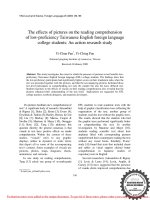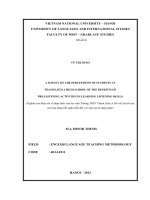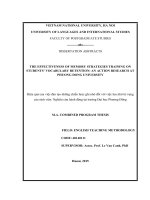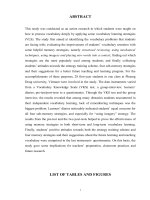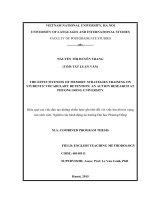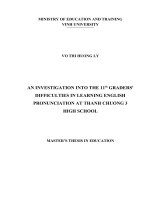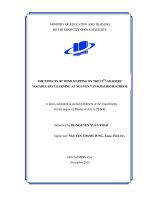The effects of mind mapping on the 6th graders’ vocabulary retention an action research project at thanh my junior high school
Bạn đang xem bản rút gọn của tài liệu. Xem và tải ngay bản đầy đủ của tài liệu tại đây (3.81 MB, 107 trang )
VIETNAM NATIONAL UNIVERSITY, HANOI
UNIVERSITY OF LANGUAGES AND INTERNATIONAL STUDIES
FACULTY OF POST-GRADUATE STUDIES
*****************
TRẦN THỊ VÂN NGA
THE EFECTS OF MIND-MAPPING ON 6TH
GRADERS’ VOCABULARY RETENTION: AN
ACTION RESEARCH PROJECT AT THANH MY
JUNIOR HIGH SCHOOL
(Nghiên cứu ảnh hưởng của việc sử dụng bản đồ tư duy đến khả
năng nhớ từ vựng của học sinh lớp 6, trường THCS Thanh Mỹ)
M.A. MINOR PROGRAMME THESIS
Field: English Teaching Methodology
Code: 60140111
HANOI - 2016
VIETNAM NATIONAL UNIVERSITY, HANOI
UNIVERSITY OF LANGUAGES AND INTERNATIONAL STUDIES
FACULTY OF POST-GRADUATE STUDIES
*****************
TRẦN THỊ VÂN NGA
THE EFECTS OF MIND-MAPPING ON 6TH
GRADERS’ VOCABULARY RETENTION: AN
ACTION RESEARCH PROJECT AT THANH MY
JUNIOR HIGH SCHOOL
(Nghiên cứu ảnh hưởng của việc sử dụng bản đồ tư duy đến khả
năng nhớ từ vựng của học sinh lớp 6, trường THCS Thanh Mỹ)
M.A. MINOR PROGRAMME THESIS
Field: English Teaching Methodology
Code: 60140111
Supervisor: Assoc. Prof. Dr. NGUYỄN VĂN TRÀO
HANOI - 2016
DECLARATION
I hereby declare this thesis is the result of my own research and that the
substance of the thesis has not, wholly or part, been submitted for a degree to
any other university or institution.
Hanoi, October 2016
Trần Thị vân Nga
i
ACKNOWLEDGEMENTS
I would like to express my special gratitude to my advisor,
Mr.Nguyen Van Trao, Assoc.Prof.Dr for his patience in guiding and supervising
me during the process of this thesis writing.
My special thanks go to my colleagues from Thanh My Junior high school
for their cooperation and support during this study.
The writer would also like to express appreciation to the staff menbers and
the teachers of post-graduate department of University of Languages and
International Studies-Vietnam National University for giving me favourable to
completing the thesis.
Finally I would like to dedicate my big appreciations to my family who
have support me a lot during my study.
ii
ABSTRACT
The aims of this research are to find out the effects of mind-mapping on
6 graders‟ vocabulary retention at Thanh My junior high school. To limit the
aspects to be analyzed in this study, I formulate two research questions: (1) To
what extends does the use of mind-mapping affect the students‟ vocabulary
retention? (2) What are the students‟ attitudes toward vocabulary learning?
th
In the study, I carried out an action research with the 6A1 students of
Thanh My junior high school. Data of this study were obtained from the results
of questionnaires and from pre-test and post-test results. Two instruments for
collecting the data were (1) questionnaires toward vocabulary learning before
and after applying the mind -mapping in teaching vocabulary and (2) the pretest and post- test.
The findings of the data analysis showed that (1) Mind-mapping can help
the students to improve their abilities in memorizing English vocabulary
items; (2) the students had positive attitudes toward the mind-mapping. Mindmapping is hoped to be a promising technique to teach and learn vocabulary.
iii
I.LIST OF TABLES AND FIGURES
1.Table 1: Research schedule
2.Table 2: Result of questionnaire 1
3. Table 3: The causes of the problems encountered by the 6A1 class students
4.Table 4: The activities applied in the study
5.Table 5: Relationship between causes of the problems and the activities
6. Result of questionnaire 2
II. LIST OF FIGURES
Figure I: First step in creating mind-mapping: „drawing a central image‟.
Figure II: Second step in creating mind mapping: „drawing main branches‟
Figure III:Third step in creating mind mapping: „drawing second branch‟
Figure IV: Environment diagram
Figure V: Sports and games diagram
Figure VI: Completing the mind-mapping diagram
II. LIST OF CHARTS
Chart 1: Result of the pre-test
Chart 2: Result of the post-test
Chart 3: Comparison between the pre-test anhd the post-test
iv
TABLE OF CONTENTS
ACKHNOWLEDGEMENTS
ASTRACT
LIST OF TABLE, FIGURES AND CHART
PART A: INTRODUCTION
1.Rationale
2. Aims of the study
3. Research questions
4. Scope of the study
5. Design of the study
PART B: DEVELOPMEMT
Chapter I: Literature Review
1.1.Vocabulary
1.1.1.Vocabualry definition
1.1.2. The importance of the vocabulary
1.1.3.Kinds of vocabulary
1.1.4.Vocabulary teaching
1.1.5.Vocabulary retention
1.2. Mind-mapping
1.2.1.Definition of mind-mapping
1.2.2.Functions of mind-mapping
1.2.3.Characteristics of mind mapping
1.2.4. Procedures in making a mind-mapping
1.2.5.Steps to read a mind-mapping
1.2.6.The application of mind-mapping to teaching a foreign language
1.2.7.The use of mind-mapping in vocabulary learning
1.3.Previuos studies
1.3.1.Review of related studies worldwide
1.3.2.Review of related study in Viet Nam
Chapter II: Methodology
2.1.Action research
2.2. Research procedures
2.3 Setting of the study
2.4.Participants
v
ii
iii
iv
1
1
2
2
3
3
4
4
4
4
4
5
6
8
10
11
11
12
12
12
13
14
18
18
19
21
21
21
22
23
2.5.Data collection instruments
2.6. Research procedures
2.6.1.Reconnaissance
2.6.2.Planning
2.6.3.Implememting the action
2.6.4.Reflection
Chapter III. Research findings
3.1.Initial data analysis
3.1.1.Data from questionnaire 1
3.1.2.Result of the pre-test
3.1.3.Identification of causes of the problems
3.2.Action plan
3.2.1. Determining the actions
3.2.2.Relationship between the causes of the problems and the action
3.2.3.The implememtation of mind-mapping in vocabulary learning
3.3.Post data
3.3.1. Result of questionnaire 2
3.3.Result of the post-test
3.4.Majors findings
3.5.Discussion
PART C: CONCLUTION
1.Pedagogical implecations
2. Limitations of the study
3. Suggestions for further study
4. Conclusion
REFERENCE
APPENDIXS
vi
23
27
27
27
28
29
30
30
30
32
33
33
33
34
37
39
39
40
42
44
47
47
48
48
49
50
I
PART A: INTRODUCTION
1. Rationale
In terms of students‟ competences, the teaching of English at the sixth grade has
the aim at developing the four language skills: speaking, listening, reading, and
writing. This means that the students are expected to practice these language skills
through the activities given in the class. In supporting the development of the four
language skills, it is necessary to learn language components. In the sixth grade
classes, the language components include pronunciation, grammar, spelling, and
vocabulary.
Vocabulary is one of the language components that play a significant part in the
development of the language skills. In the sixth grade, building up a useful vocabulary
is important to the teaching of a foreign language (Cameron, 2001: 72). It shows that
English materials for sixth grade students focus on enriching the students‟ vocabulary.
To have a good memorization on vocabulary, the students are expected to be able to
use the language successfully and efficiently including using it to develop their
language skills in class activities.
Nevertheless, learning English vocabulary is challenging for the sixth grade
students at Thanh My Junior High School (TMJHS). After observing and conducting
an interview at the school, the teacher found that there were two problems that
involved the learning English vocabulary of the TMJHS. Firstly, the students felt
difficult to memorize and recall English vocabulary items including their
pronunciation, their spelling and especially their meaning. The students usually cannot
remember the words for long and recall them when needed. Secondly, the teaching
technique was not very interesting and motivating. The students got bored with the
way of teaching the teacher used. The teacher often asked the students to find the new
words then he or she explained the meaning of the words. After that the students had
to write the list of the new words in their notebook and learn them by heart.
To learn English vocabulary, memorization is very important. In mastering
English vocabulary, the students do not only need to learn a lot of English words but
also to remember them (Thornbury, 2002: 23). Accordingly, low proficiency makes
students find an obstacle in acquiring the language knowledge and taking part in class
activities. It is clear that they could not communicate well because they lack words
they need.
One of the causes of the students‟ low vocabulary retention is likely their
learning habits. The ways they learn new words are various: such as writing down
1
words on a piece of paper, learning words by heart, heavily depending on wordlists in
textbook, passively waiting for teacher‟s explanation for new words. These ways do
not seem to be effective and make them bored with learning vocabulary. So as to
memorize new items, students often use rote memorization techniques. As some of the
students said, they used to write down the words for several times, to speak aloud the
words and to make sentences with words. They admitted that they could not recall
most of the words they had learnt before because there were no clues. It can be seen
that the students‟ bad memory is due to the lack of appropriate vocabulary learning
technique. They are not given different ways of learning vocabulary and are not
encouraged to use them as a strategy of learning vocabulary. Therefore, learning new
words is not very enjoyable for the learners.
This study aims to help the students to be more successful in English
vocabulary retention and to motivate them in learning words. For this purpose, mindmapping is used as a technique to improve the students’ vocabulary retention and
motivate them in learning vocabulary.
2. Aims of the study
The aims of this study are to find the way to improve vocabulary retention of
the 6A1 students of TMJHS and to motivate them in learning English vocabulary.
3. Research questions
To obtain the stated aims, the following research questions are formulated:
(1) To what extent does the use of mind-mapping affect the students‟
vocabulary retention?
(2) What are the students‟ attitudes toward vocabulary learning?
4. Scope of the Study
In this study, the researcher uses one class and the research is done at the sixth
grade of Thanh My junior high school. The researcher hopes that the findings of this
study will give benefits and contribution for some parties. Firstly, for the English
teachers, the results of the study can be applied for the betterment of the English
teaching and learning process especially in presenting English vocabulary to the
students. The study will be considered as the first step to improve the effectiveness of
the teaching learning process by using mind-mapping to introduce lesson materials at
TMJHS. Secondly, for the sixth grade of TMJHS students, they are expected to enjoy
learning vocabulary with mind-mapping. The use of mind-mapping as the technique in
learning English vocabulary can be considered as an effective way of note-taking to
2
memorize English words easily. The last is for other researchers. The study can give
general knowledge of materials that can be done for research studies in relation to
vocabulary learning in the secondary level of education.
5. Design of the study
The thesis consists of three main parts:
Part A: Introduction introduces the rationale, the aims, the research questions, the
scope and the design of the study.
Part B: Development is divided into 3 chapters.
Chapter 1: Literature Review presents theories related to vocabulary, mind-mapping.
Previous studies on mind-mapping are also reviewed.
Chapter 2: Methodology presents the research methods, the setting of the study, the
participants, the research data and the research procedures.
Chapter 3: Findings and Discussion presents the analysis of initial collected data to
determine the problems, then the action plan. The analysis of post-treatment data was
then presented along with which the discussions were given.
Part C: Conclusion provides the pedagogical implications, some limitations of the
study and suggestions for future study.
3
PART B: DEVELOPMENT
CHARPER I: LITERATURE REVIEW
1.1. Vocabulary
1.1.1. Vocabulary definition
McCarthy (1990: 32) defined vocabulary as words in a specific language or
freestanding items of language that have meaning. According to Penny Ur (1996: 122)
vocabulary is defined roughly as “the words we teach in the foreign language”. She also
stated that “a new item of vocabulary may be more than a single word, a compound of
two or three words (e.g., bus stop, father -in-law), and multi-word idioms (e.g., call it a
day)”.
As can be seen, vocabulary is defined in many different ways. It refers to words or
a group of words in a language and knowledge of words regarding its meanings, forms,
and how to use it correctly in the context. In this study, vocabulary refers to the words,
compounds and phases in a language that could be use to exchange information in oral
and written communication.
1.1.2. The importance of vocabulary
Vocabulary plays a significant role in language learning activities. It consists of all
the words that we usually used when the other language skills are studied. Learning
vocabulary does not mean learning word isolation. We should learn words in context
because a word may have different meanings in different contexts. According to French
(1983: 1), the meaning of the word will be dependent on the context itself and word in
isolation usually does not associate with the intended meaning. The English words and
their meaning should not be useful unless we know how to organize the words
meaningfully in a sentence. However, vocabulary growth depends on the students‟
experiences. Words must match with the meaning so as to be useful for communication.
Vocabulary has an important role in mastering a language. Whoever wants to master well
a language needs to have good vocabulary retention. Memorizing vocabulary is the first
step to master English well. Therefore the students will have problems in mastering
English when lacking the vocabulary. They find it hard to express their idea clearly and
also they could not understand the teacher‟s explanation because they do not know the
meaning of words used by the teacher. Moreover, they have difficulties in understanding
books, newspapers, magazines written in English, or even in understanding the radio
4
broadcast or television programs. So the retention of a great number of vocabularies is
necessary to use English. In other words, vocabulary as an important tool helps the
students to understand when they listen or read something in English. Harmer (1991: 23)
said that we should ensure that our students memorize the vocabulary they need for their
level and that they can recall them when needed. The vocabulary is one of the language
aspects along with grammar and pronunciation which is considered a tool to support the
ability to communicate in English.
1.1.3. Kinds of vocabulary
In vocabulary learning, the words to be learned can be classified into two categories
which are content words and function words. Content words carry a lexical meaning, and
function words cover grammatical meaning. In language, to understand functions of
words students can arrange words in a correct sentence and analyze the sentence
(Cameron 2001: 82). Based on the meaning of words, content words are the word classes
of nouns, verbs, adjectives, and adverbs. In teaching content words, the teacher can
explain the words and their meanings in a direct and explicit way (Cameron 2001: 82). On
the other hand, function words are the classes of articles, prepositions, conjunctions, and
pronouns. In teaching function words, the teacher teaches words incidentally and uses
them continuously in a range of different discourse contexts (Cameron, 2001).
However, according to Nation (2001: 78), groups of English vocabulary have been
categorized by frequency of overall occurrence in order to determine which words are
most necessary for students to learn. There are two common divisions: high-frequency
words and low-frequency words. High-frequency words which, include function words
and content words, account for a very large proportion of the running words in spoken
and written texts and occur in all kinds of uses of the language. Low-frequency words
cover over 5 percent of the words in an academic text. In fact, English students try their
best to master a large amount of vocabulary. Based on the learners‟ English level and the
discussed issue, vocabulary and its compounds and idioms focused in the present study
will be chosen basing on frequency and usefulness to the need of the learners.
1.1.4. Vocabulary teaching
According to Thornbury (2004), vocabulary is usually a problem of memorizing.
In order to teach it effectively, it is important for the teacher to know how to make
students remember words and store them in students‟ mind for long-term.
5
Some writers (Thornbury, 2004; Mccarthy, 1992; Gairns and Redman, 1986) claim
that the vocabulary is well stored in the mind, in a complex web-like system called
“mental lexicon”. In this regard, words are stored, classified and interconnected in
different ways accordance with their features such as form, meaning, collocations,
properties, cultural background. As a result, a word can be looked up through some
pathway at once.
Therefore, the language teacher plays an important role in helping their students
determine the easiest way to convey new words into the already existing web of the
mental lexicon (Thornbury, 2004). In addition, it is necessary for the students to acquire
the capacity to store the information for long-term.
Research into memory of Thornbury (2004) suggests principles to support the
process of permanent remembering. In this research, he listed some techniques to make
vocabulary teaching effective.
The first technique is repetition for example in reading. Moreover, he also focuses
on the importance of use and retrieval of the new words: eg, use the new words to
complete the sentences.
Furthermore, Thornburry thinks that the presentation of new words should be
divided into separated sequences that are followed by repeated revision later in the next
sections or periods.
Motivation, which is another helpful element, is closely linked with attention.
Thornburry states that an arousal (a very high degree of attention) seems to relate with
improved recall.
Finally, according to Thornburry (2004), visualization of a picture for a new
vocabulary item or link an abstract word with several metal images should be done by the
teacher. Images can help students draw themselves the best outcomes. Thornburry claims
one more time that the students‟ own images give the best influence on memorizing.
To concern this problem, Gairns and Redman (1986) emphasized the significance
of activities in the classroom. They thought that the activities need to be presented in
detail so information is more likely to be remembered in long-term memory. Moreover,
they together Thornburry presented the positive influence of imaging, repetition…They
also suggest a good technique “word diagram” to support retention which might be useful
for “storage of lexis”.
6
Traditionally, students have not been taught vocabulary in a particular lesson but
along with lessons of listening, speaking, reading or writing. Some learners make a list
then put into it the meaning of new words in their mother tongue without any real context.
Learners often look up the meaning of the words in the dictionary or ask the teacher to
translate the words and try to learn them by heart. There are some other traditional
techniques such as illustration, mime…For those techniques, the learners are usually
passive and the lessons center on the teachers. Consequently, the students usually have
difficulties in memorizing and recalling the words.
The current trends in teaching vocabulary stress on helping learners memorizing
the words that they have learn and relate words with others or in different contexts.
Learners should not learn words in isolation (Harmer, 1991)
Mind-mapping is considered as an example of current trends in teaching
vocabulary. Mind-mapping is a visual organizer that promotes vocabulary development.
Mind-mapping is a creative note-taking strategy which makes us easy to memorize the
information. Buzan (2009) thinks that mind-mapping is a powerful technique graphic,
which provides universal key to unlock the potential of brain. Mind-mapping technique
imitates the thinking process, makes it possible for us to move from one topic to another
topic back and forth. A pattern with pictures, color, symbol not only makes the learners
understand the vocabulary knowledge but also makes them feel good and enjoyable and it
can attract them to pay attention to the vocabulary knowledge then retain the words. In
contrast with the traditional technique, the current ones are considered the positive change
for a new teaching and learning process. The teachers are now not only the knowledge
provider but also the initiator, the guider and the controller. The students also get engaged
with the learning process. They could discuss and interact with their teachers, exchange
information with their classmates.
Despite the advantages it can bring, mind-mapping exhibits some limitations.
Mind-mapping can give the danger of introducing closely related new vocabulary items at
the same time. Learners find troubles in relation with too many vocabulary items. This
makes learners‟ task more difficult.
1.1.5. Vocabulary retention
1.1.5.1. Vocabulary retention
7
The Longman dictionary defines retention in some way. It is also the condition of
being retained or the act of retaining. It is the power and capacity of retaining and ability
to recognize or recall what has been experienced or learned.
According to Oxford dictionary, vocabulary retention is the fact of keeping
information in one‟s memory or is the power or capacity of holding and absorbing a
certain number of words in their memory. Vocabulary retention can refer to short-term
memory and long-term memory retention.
1.1.5.2. Short-term and long-term memory
Memory is divided into short-term and long-term memory base on duration of
memory retention and capacity of recalling information after the original input. Longterm memory is used to retain information in anything but the immediate future. Shortterm memory is to store or keep information while it is being processed. The object of
vocabulary learning is to transfer the lexical information from the short-term memory to
the more permanent long-term memory (Schmitt, 2000). However, we can not
distinguish clearly short-term retention and long-term retention. Information entering
short-term memory may pass quite effortlessly into long-term memory, and some learners
may find repetition a very effective way of transferring information into long-term
memory.
When learning vocabulary, learners often have difficulties in retention of words for
a long time. They do not usually succeed in putting the words into long-term memory. In
the present study, short-term memory is referred as the initial memory of the word
meaning at the end of the lessons whereas the number of words can be recalled at the next
lessons or at the end of the study is considered as one form long -term memory because
the participants in the study have only three forty-five-minute lessons per week.
1.5.3. Major factors affecting word retention
There are many reasons why students remember words better than others. For
example, nature of the words themselves, situations under which the words are learnt,
how the words are taught to students and so on affect word retention. Gairns and Redman
(1986) pointed out that learning new items involves storing them first in the short-term
memory and afterwards in the long-term memory, and the long-term memory can hold
any amount of information. They showed that our “mental lexicon” is highly organized
and efficient, and that semantic related items are stored together. Another factor affecting
8
storage is word frequency because the most frequently used items are easier to retrieve.
We can facilitate the leaning process by classifying items of vocabulary in semantic fields
such as topics.
Besides, retrieval is another difficulty faced by the learners when learning
vocabulary. According to Nunan (1990) learners can be motivated to develop their own
personal learning styles for vocabulary, in such areas as memorizing and retaining new
words. However, Cater et al. (1989) showed that the storage of information does not
guarantee its retrieval. Learners need to increase the effectiveness of retrieval probability
because they need techniques to recall appropriate words for particular occasion. Cater
also pointed out that the meanings of words are focused rather than on their forms to
enhance production, as most of our production has to do with searching for an appropriate
meaning to fit the specific situation. The most effective is to associate bonds for
production, therefore, connect the words with their meanings.
1.5.4. Indicators of students’ vocabulary retention
In vocabulary teaching learning, both teacher and student will happy if teaching
learning process gains good result. Teacher can be said to be successful in his teaching
language if the students can mastery four skills in language, they are listening, reading,
speaking, and writing, of course vocabulary retention become a basic aspect to support
that skills.
These are some indicators of vocabulary retention suitable with the school
curriculum especially for Junior High School. They are:
* Students can identify, understand, grasp and remember the meaning of words in the
text.
* Students can pronounce the words correctly.
* Students can use and write the words correctly, so they can write a composition
well.
* Students have high score in the vocabulary test.
According to (Nation, 2001), vocabulary learning strategies are one part of
language learning strategies which in turn are part of general learning strategies. Gu, Y
(2000, p.85-86) cites some vocabulary learning strategies such as cognitive,
metacognitive memory and activation strategies
9
Metacognitive strategies entail selective attention and self-initiation strategies.
Cognitive strategies consist of guessing strategies, skillful use of dictionaries and notetaking strategies. Memory strategies are grouped into rehearsal and encoding categories.
Word lists and repetition are instances of rehearsal strategies. Encoding strategies include
such strategies as association, imagery, visual, auditory, semantic, and contextual
encoding as well as word-structure. Activation strategies encompass those strategies
through which the learners actually use new words in different contexts.
With regard to word meaning and retrieval, many researchers (Hague, 1987; Cater,
1989; Amer, 2002) agreed that mind-mapping is effective for long-term memory and
support the recall. Therefore, in this study, the mind-mapping technique will be presented
in the next section.
1.2. Mind-mapping
1.2.1. Definition of mind-mapping
Mind-mapping is a creative note taking technique in a visualization and graphic
form that is used to make people feel easy in entering information into their brains,
keeping information in a long term memory and taking it out from their brains easily by
engaging imagination and association (Buzan 2006: 6; Buzan 2009: 10). In this definition,
there are five important concepts of mind-mapping. Firstly, mind-mapping is one of
creative note taking techniques used by people to represent ideas into visualization and
graphic forms where one idea is connected to another idea by using branches. Secondly,
by using mind mapping, it is easy for people to enter the information into their brains.
Also, mind-mapping supports to put information into their memory. Thirdly, mind
mapping helps people to keep information in the long term memory. Fourthly,
information can be easily taken out from their brain when using mind-mapping. Finally,
mind-mapping involves the use of imagination and association in its application. This
means that in presenting ideas into mind-mapping diagrams, people enclose imagination
stimulators such as pictures, symbols, and colors to present ideas clearly and use
association techniques to help them build their senses to the new concepts. These new
concepts are connected to the known concepts having a tight relationship with the new
concepts.
According to Buzan (1993: 1) mind-mapping is a great graphic technique, which
gives a general key to unlock the potential of brain. Mind-mapping technique copies the
thinking process, which enable us to move from one topic to another topic back and forth.
10
Recording the information through symbols, pictures, emotional meaning and colors,
exactly the same like our brains process it. A pattern which at least consists of symbol,
picture, and color will not only help the students to understand the vocabulary knowledge
but also makes the students feel interesting, enjoyable. In addition, it can encourage the
students‟ brain and leads them to have interest in retain vocabulary knowledge.
1.2.2. Functions of mind-mapping
According to Buzan (2009:6), mind-mapping have the following functions:
* To make active all parts of brain.
* To make people (learners) be focus in the main topic.
* To help show the relation among parts of information
* To give a certain illustration in the whole and detail.
* To help group the concept and compare it.
1.2.3. Characteristics of mind-mapping
The mind map has four essential characteristics:
* The subject of attention is crystallized in a central image.
* The main themes of the subject radiate from the central image on branches.
* Branches hold a key image word printed on the associated line-details radiate
out.
* The branches form a connected structure.
1.2.4. Procedures in making a mind-mapping
The procedure in making a mind map consists of seven steps:
* Start from the centre of paper that put horizontally.
* Use images for the central ideas.
* Use color. By coloring, it can improve the energy toward creative thinking.
* Connect the main branches to the central image; connect the second and third
branches to the first and second branches and so on.
* Make a curve line as connected line among branches. It will be more interesting.
Use a key word in each line. It useful to give the mind map more energy and flexibility.
* Use image is like on central image (Buzan, 2009: 15-16).
1.2.5. Steps to read a mind-mapping
The steps to read a mind map, as follows:
11
* Start in the centre that is the focus of the mind map.
* Words/images closest to the central image show the main themes of the mindmap. This is the start of the radiant hierarchical structure.
* Select one main theme and read out from the centre along the branch. This
provides greater levels of associated detail.
* Notice links between the branches.
1.2.6. The application of mind-mapping to teaching a foreign language.
It is obvious that memory plays an important role in learning and mastering a
foreign language. In the communicative approach, learners need to retain words and use
them effectively.
Mind-mapping is a helpful memory technique which makes it easier to remember
new materials and to visualize the thinking process, so mind-mapping proves to be a very
helpful tool to master a foreign language. Although it may cost time to use the technique,
it will eventually speed up the learning process when learners know and understand how
to use it.
Casco (2009) suggests some applications of mind-mapping in teaching a foreign
language which can be presented as follows:
Engage the learners:
Thanks to the map, the learners know easily what comes next and focus the
learners‟ attention on the topic. Moreover, the map supports a structure to reduce the
learners‟ anxiety when they receive input through listening and reading when they speak.
Active prior knowledge
The use of keywords stimulates memory of what the student know about the topic.
Encourage the learner to ask questions:
The map shows clearly what the students know and what they do not know about
the topic. Image and interrogation marks widen the information gap and encourage the
learners to find out what they do not know.
Scaffold reading and listening comprehension:
The map is an efficient tool to facilitate comprehension because it offers the
students a globe view of listening or reading contents. Furthermore, the cues showing in
the map helps the learner to form inferences as an aid to understanding.
Scaffold speaking
12
The map helps the learner to organize their thought and speech. Thanks to the
different linked and cross-referenced elements of the map allow the learner to create a
various discourse each time he/she use the map.
Assess oral production
The map can assess the students‟ oral production by explaining the link of the
maps. The learner has to use new structure and lexical items to introduce the content of
the map.
Scaffold written production
The map can be considered the starting point or the outline to write a paragraph or
an essay on the topic explored.
Casco (2009) showed that mind-mapping has a lot of benefits in teaching a foreign
language in many aspects consisting of reading, writing, reading skill as well as in
motivating the learners and activating the prior knowledge.
1.2.7. The Use of Mind Mapping in Vocabulary Learning
In vocabulary learning, mind-mapping can be used in some activities: presenting
and reviewing English vocabulary. In this study, for example, the English teacher can use
mind-mapping diagrams to help the students to understand English words and their
meaning, and make the words easier to be memorized (Buzan, 2006: 201).
Mind-mapping is a creative note-taking form which applies visualization and
graphic forms. To create mind-mapping diagrams, the teacher or students need to follow
some steps. Below, Tony Buzan presented four steps in creating the mind-mapping
diagram as examples of the use of mind-mapping in vocabulary learning (Buzan, 2006:
21-23). However, the teacher can use the software to create the mind-mapping diagram.
The software which is quite convenient and easy to operate, also help the teacher to save
the time.
Creating mind-mapping diagrams
A frame of mind-mapping diagram is made by using color pencils, a piece of plain
paper in a landscape position, pictures, key words, and association. A frame of the mindmapping diagram can be made by doing the steps below.
To make a frame of mind-mapping, we should use color pencils, paper, pictures,
keys words and association in traditional way but in this study I will introduce another
13
way to create mind-mapping diagram by using the software iMinMap7. A mind-mapping
can be easily made thanks to the support of this software by doing the following steps
Firstly, the teacher draws or chooses a picture as a central image in the middle part
of the paper (Buzan, 2006: 21). The page should be placed in a landscape position. Here,
the central image is used to describe the main idea or to be more understandable, we
should write key words along with the image. It is to activate the learners‟ right brains,
strengthen the learners‟ memory, and make the learning enjoyable. The steps in creating
of “Sports and Games” diagram are presented as an example. The first step is shown in
Figure I below.
Figure I: First step in creating mind-mapping: ‘drawing a central image’.
Secondly, the teacher draws curve lines and boxes around the central image to
build main branches or basic ordering ideas (Buzan, 2006: 24-25). The main branches
have tight relationship with the topic idea. Then, a picture or symbol and keyword in
every main branch tip is made to strengthen the writing of keywords and make it easy to
be understood (Buzan, 2006: 26).The pictures in the mind-mapping diagram (Figure II)
below show the kind of sports as branch keywords.
Finally, the teacher makes the second and the third branches and so on. The second
branches are radiated from the main branches. The second branches are created to present
ideas related to ideas in the main branches. At the tips of second branches, the teacher
adds pictures or symbols and keyword. Figure III below is an example.
14
Figure II: Second step in creating mind mapping: ‘drawing main branches’.
15
Figure III: Third step in creating mind mapping: ‘drawing second branch’
16
Presenting vocabulary by using mind-mapping
The teacher presents the vocabulary items by using the frame of the mind-mapping
diagram which has been prepared and places it on the blackboard or screen of projector.
The teacher can do some steps before when vocabulary items are introduced. The teacher
presents materials in mind-mapping based on the sequences of the steps in creating mindmapping. These steps are described below:
First, a frame of the mind-mapping diagram should be placed on the middle of the
blackboard or screen to make sure that all students could see the content of the mindmapping diagram. Second, the teacher introduces the lesson topic by using the central
image of the mind-mapping diagram (Buzan, 2006: 21). Then, the teacher starts to present
English words in the main branches one by one based on the pictures in the branches
(Buzan, 2006: 24-25). Then, she asks students to guess a word from each picture .Then,
she writes the word in the available branch (Ellis, 1993:88). In presenting the words in the
second branches, the teacher does the same way as the step in presenting the ones in the
main branches. After the teacher finishes in completing the mind -mapping diagram, she
asks the students to pronounce all or some important words presented in the mindmapping diagram to check whether or not the students pronounce correctly the words.
With the support of color and images illustrated in Figure III, mind-mapping
could help students a lot in learning words and organizing the ideas systematically. In
fact, the students have to usually take a lot of effort to retain words and sentences;
whereas by visualizing them, it makes us much easier to memorize and recall the words.
1.3. Previous studies
1.3.1. Review of related studies worldwide
Looking for studies related to using mind-mapping technique in teaching language
in the world, the researcher found several ones. The study Teaching vocabulary through
MM technique to the ten grade students of SMA Negeri 15 Palembang was written by
Effendi (2004). Through the analysis of the data collected during the study, the researcher
concluded that it existed a significant difference between the students‟ process in the
experimental group (using mind-mapping technique) and the control group (using
traditional method) and it can be concluded that mind-mapping is an effective technique
to teach vocabulary to ten grade students of SMA Negeri 15 Palebang.
17
